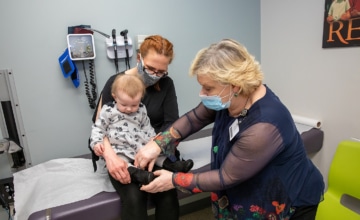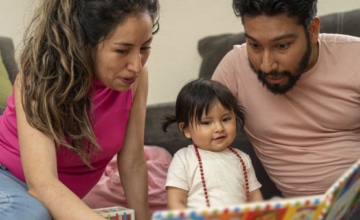Learn how to best support young children in families that have been affected by the loss of a pregnancy or young infant.
Sadly, there are times when families experience devastating losses. An expectant mother may lose her baby during the pregnancy or, more rarely, the baby may die during childbirth or soon after birth. During this time, each family (and each member of the family) may experience the loss and express grief differently. While this resource is not a detailed guide to supporting families through the grieving process, it does provide information on how to best support young children in families that have been affected by the loss of a pregnancy or young infant.
Offering Support
In these situations, it is important to directly acknowledge the family’s loss and offer words of comfort and love. Sometimes parents feel this kind of loss is not acknowledged as a “real” loss, which can be very painful. In addition, family, friends, hospital staff, and others may wish to share their remembrances of the pregnancy and/or baby with parents. Sharing these memories lets parents know that their baby was an important part of his or her community. Finally, hands-on support—such as child care for older children in the family, prepared meals, doing errands—will also likely be appreciated.
While families naturally receive the most support immediately after the loss, friends and family members may wish to check in with parents regularly over the next few months. It may take time for the true impact of the loss to set in. In addition, families may need enhanced support should they become pregnant again, as this new pregnancy is likely to evoke strong feelings (often including worry, grief, and fear).
Some parents may take photos or handprints of their deceased child, or clip a lock of hair, and share these with their family and friends. Some parents choose to name the baby who has died; others do not. Grieving parents may organize a memorial service, funeral, or other ritual to recognize the loss. Some families may include siblings, others may not. Parents may display photos of their deceased child in the home as a way to give him/her a place in the family. Or they may not.
These are intensely private and personal decisions for families experiencing a devastating loss. It is important for family and friends to understand that there is no one “right” way to grieve.
Talking About the Loss With Young Children
Grieving parents may wonder whether (and how) to discuss their loss with their young children. In general, experts recommend explaining to children, in age-appropriate ways, what has happened. Children who are too young to understand death still need to know why their parents are so distressed.
While there is often a natural temptation to protect children by avoiding discussion of the loss, this can have the opposite effect. Children know (or sense) that something very significant has happened in their family. They need to have their feelings validated by the important adults in their lives. When parents allow children to talk about the loss and answer their questions with age-appropriate honesty, children can process their difficult and confusing feelings. This allows them to make sense of the experience in a healthy way, by including the deceased child as part of their image of the family as a whole.
Below are some guidelines for talking about the loss.
Children under age 3 need simple, straightforward, and truthful explanations.
“The baby came out of Mommy’s tummy too soon. He was too little to live outside of Mommy and so he died.” Or you might say, “The baby wasn’t strong enough to live outside of Mommy’s body.” Providing more information than children are asking for can increase their anxiety. Start off by giving a simple explanation and then ask if the child has any more questions. Common questions about the loss include:
- Where is the baby now? Toddlers can be confused by expressions like: “The baby went to a better place.” A young toddler may believe that the baby is literally in another place. Parents can offer an age-appropriate answer that reflects their personal beliefs.
- Will I die? Will you die? Parents can acknowledge the fear but offer reassurance: “I can see why you are worried about that, but we are all strong and healthy so we are not going to die until we are very, very old a long time from now.”
- What is dying? Keep in mind that young children are not capable of fully understanding death. It can help to offer a simple, concrete explanation: “Our baby’s body stopped working. She couldn’t eat, or play, or move her body like we do.”
Children who witnessed any frightening aspect of the loss need to hear what happened in age-appropriate terms.
For example, children may see/hear the ambulance arrive, observe their parent’s fear and worry, or see signs of physical distress such as bleeding. Parents can explain, “It was scary when Mommy’s tummy started to hurt, which let us know there was something wrong. Mommy went to the hospital so they could help.”
Parents may notice behavior changes in their children after the loss.
Young children may become more clingy or demanding, or experience periods of intense separation anxiety. Children may also show changes in sleeping or toileting patterns. These changes are usually temporary and gradually disappear over time.
Young children may ask the same questions over and over again.
This is because toddlers and preschoolers learn through repetition. Hearing the same explanations again and again helps them make sense of this confusing and distressing experience.
Parents should know that it is okay to cry in front of their child, though it is important to explain why:
“I am crying because I am very sad that our baby died.” If, however, parents feel their grief is making it difficult to care for their children, counseling will be a critical support.
Resources
Helpful organizations for families experiencing this type of loss include:
Share: Pregnancy & Infant Loss Support, Inc.—www.nationalshare.org —offers online information and support for loss during pregnancy or the newborn period. The site also provides a locator tool to find local support groups for families who have experienced early pregnancy loss, stillbirth, or loss in the first few months of life.
Compassionate Friends—www.compassionatefriends.org —offers online information and grief support following the death of a child. The site also provides a locator tool to identify local support groups.
Now I Lay Me Down to Sleep—www.nowilaymedowntosleep.org —provides high-quality photography of the deceased child by professional photographers at no charge to families.
Centering Corporation—www.centering.org —provides education and resources to parents and children experiencing loss. Books for adults addressing early loss include those listed below.
Books for children addressing the loss of an expected sibling include:
Empty Arms: Coping With Miscarriage, Stillbirth, and Infant Death by Sherokee Ilse (2008, Wintergreen Press).
Empty Cradle, Broken Heart: Surviving the Death of Your Baby by Deborah L. Davis (1996, Fulcrum Publishing).
Something Happened: A Book for Children and Parents Who Have Experienced Pregnancy Loss by Cathy Blanford (2008, Cathy Blanford Publishing). Appropriate for children aged 2–6.
Where’s Jess: For Children Who Have a Brother or Sister Die by Marvin Johnson (1982, Centering Corporation). Appropriate for children aged 3–6.
Stacy Had a Little Sister by Wendie Old (Albert Whitman & Company, 1994). Appropriate for children aged 4–9.
Since My Brother Died: Desde que Murio Mi Hermano by Marisol Munoz-Kiehne (2000, Centering Corporation). Appropriate for children aged 5–9.




